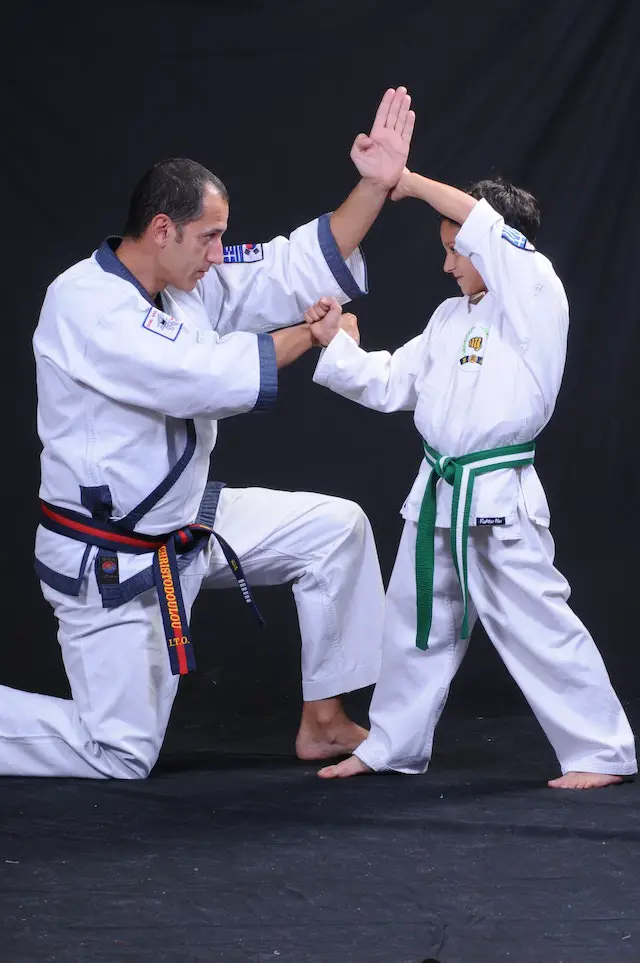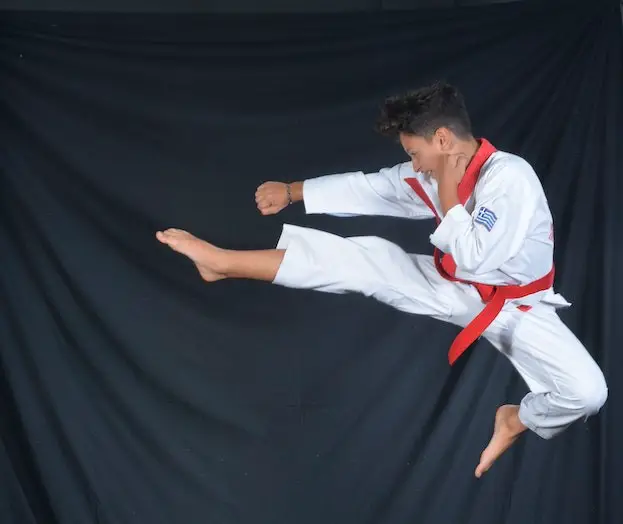Tang Soo Do focuses on the technical aspects of martial arts, including hand strikes, kicks, and stances. On the other hand, Taekwondo emphasizes speed and agility through high-flying kicks.
What is Tang Soo Do?
(Photo by Christoforos Christodoulou)

Tang Soo Do is a Korean martial art that focuses on the development of physical, mental and spiritual aspects of an individual. The name Tang Soo Do translates to “the way of the Chinese hand” which reflects its roots in both Korean and Chinese martial arts.
Tang Soo Do emphasizes strikes, kicks, blocks and circular movements using open-hand techniques. It also incorporates elements like forms (hyung), sparring (kumite) and weapons training (moo do).
The discipline promotes self-defense skills as well as personal growth through character building principles such as respect, humility and perseverance. It aims to cultivate a strong spirit that can withstand life’s challenges.
Tang Soo Do has become popular worldwide due to its effectiveness in combat situations, health benefits for practitioners of all ages, and positive impact on personal development. With its focus on balance between mind and body, it provides a holistic approach to martial arts training that goes beyond just physical fitness.
What is Taekwondo?
(Image by David Mark from Pixabay )

Taekwondo is a Korean martial art that focuses on powerful kicks and rapid movements. It was developed in the mid-20th century as a blend of traditional Korean martial arts, Japanese karate, and Chinese martial arts.
The word “taekwondo” translates to “the way of the foot and fist,” highlighting the importance of kicking techniques in this discipline. Unlike other martial arts forms that use more hand strikes, taekwondo emphasizes high-speed jumping and spinning kicks.
Taekwondo training typically involves sparring with an opponent using protective gear such as gloves, headgear, shin guards, mouthguards etc., to simulate real-life fighting situations.
In addition to its focus on physical fitness and self-defense skills, Taekwondo also has a strong emphasis on mental discipline. Practitioners are taught respect for themselves and others both inside and outside the dojo (training hall), helping them develop not just their bodies but also their minds.
Taekwondo is a dynamic sport that requires strength, agility, speed, balance – all while maintaining focus under pressure.
Tang Soo Do Vs. Taekwondo – Key differences
Tang Soo Do and Taekwondo are both popular martial arts with their origins in Korea. While they may seem similar, there are significant differences between the two.
Firstly, Tang Soo Do places a greater emphasis on hand strikes and grappling techniques. It is considered to be a more well-rounded style that also incorporates elements of Chinese martial arts. In contrast, Taekwondo focuses primarily on kicks and is more sport-oriented.
Another key difference lies in their forms or patterns. Tang Soo Do forms tend to be longer and more complex compared to Taekwondo forms which involve shorter movements but require greater speed and power.
In terms of sparring rules, Taekwondo competitions typically use electronic scoring systems while Tang Soo Do tournaments rely on judges’ decisions based on points awarded for clean hits.
The choice between Tang Soo Do or Taekwondo comes down to personal preference and goals as both styles offer unique benefits for practitioners at any level.
Is Tang Soo Do effective in a street fight?
When it comes to self-defense, many people wonder if their martial art of choice will be effective in a real-life street fight scenario. Tang Soo Do is no exception.
Tang Soo Do emphasizes kicking techniques and fluid movements that are designed to counter an attacker’s strikes with quick and powerful kicks. In addition, students learn blocks, punches, throws, joint locks and pressure point strikes.
One important aspect of Tang Soo Do training is the emphasis on situational awareness and avoiding potential dangers before they escalate into physical altercations. However, should one find themselves in such a situation where physical self-defense is necessary; the effectiveness of Tang Soo Do depends on various factors including the practitioner’s skill level, strength and technique execution.
While there are several styles which claim superiority over others when it comes to street fighting applications ,the truth lies in the individual’s ability to adapt quickly under high stress situations while using proper techniques from their chosen discipline.
Ultimately, any martial art can only take its student so far – what really counts in a street fight is your instinctual reactions based off practice sessions conducted with multiple scenarios against different opponents simulating real life attacks.
How many belts are in Tang Soo Do?
Tang Soo Do is a Korean martial art that has gained popularity around the world. The ranking system in Tang Soo Do is similar to other martial arts, with colored belts indicating different levels of proficiency.
In general, there are ten ranks or “gups” in Tang Soo Do before reaching the equivalent of black belt. Each rank is represented by a specific color belt: white, orange, green, red and blue for lower gups; brown and black for higher gups.
To advance from one level to another, students must demonstrate their knowledge and mastery of various techniques including forms (kata), sparring (free fighting) and self-defense techniques.
Unlike some other martial arts where testing can be done more frequently, it typically takes several years to progress through all the ranks in Tang Soo Do. This time frame allows students to develop a deeper understanding and appreciation for the art as they gain experience over time.
While the journey towards achieving a black belt may be long, each step along the way represents an important milestone on that path towards mastery.
Who is the best Tang Soo Do fighter?
It’s difficult to pinpoint who the best Tang Soo Do fighter is, as it ultimately comes down to personal opinion. There have been many talented practitioners of this martial art over the years, each with their own unique strengths and fighting style.
One notable name in the world of Tang Soo Do is Chuck Norris. He began training in Tang Soo Do during his time serving in the United States Air Force and went on to become a six-time undefeated World Professional Middleweight Karate Champion.
Another prominent figure in the world of Tang Soo Do is Hwang Kee, who founded Moo Duk Kwan – one of the five original kwans that helped develop Taekwondo. Despite being more recognized for his contributions towards developing Taekwondo, Hwang Kee was also a skilled practitioner of Tang Soo Do.
Other notable figures include Grand Master Jae Joon Kim, founder of Chayon-Ryu Martial Arts; Grandmaster Jun Saeng Lee, known for incorporating acrobatics into his fighting style; and Grandmaster Charles Ferraro, who has won numerous awards for his demonstrations and performances.
There are many great Tang Soo Do fighters out there who have made significant contributions to this martial art. Each with their own unique style and approach to combat.
Does Tang Soo Do have kicks?
Tang Soo Do is a martial art that incorporates various techniques, including punches, blocks, and kicks. The style emphasizes fluid movements and the use of the entire body to generate power in strikes.
One aspect that sets Tang Soo Do apart from other martial arts is its emphasis on low kicks. These kicks target an opponent’s lower extremities, making it difficult for them to maintain their balance or move effectively.
Tang Soo Do also features high kicks and spinning kicks, which require a great deal of flexibility and coordination to execute properly. Practitioners typically spend significant time working on their kicking technique in order to achieve maximum speed and power.
Tang Soo Do places a strong emphasis on striking with the legs as well as the arms, emphasizing that both are equally important parts of effective self-defense techniques. Whether you’re looking to improve your physical fitness or learn practical self-defense skills, Tang Soo Do’s focus on powerful kicking techniques can be an excellent addition to your training regimen.
Featured Image By – Photo by Christoforos Christodoulou








